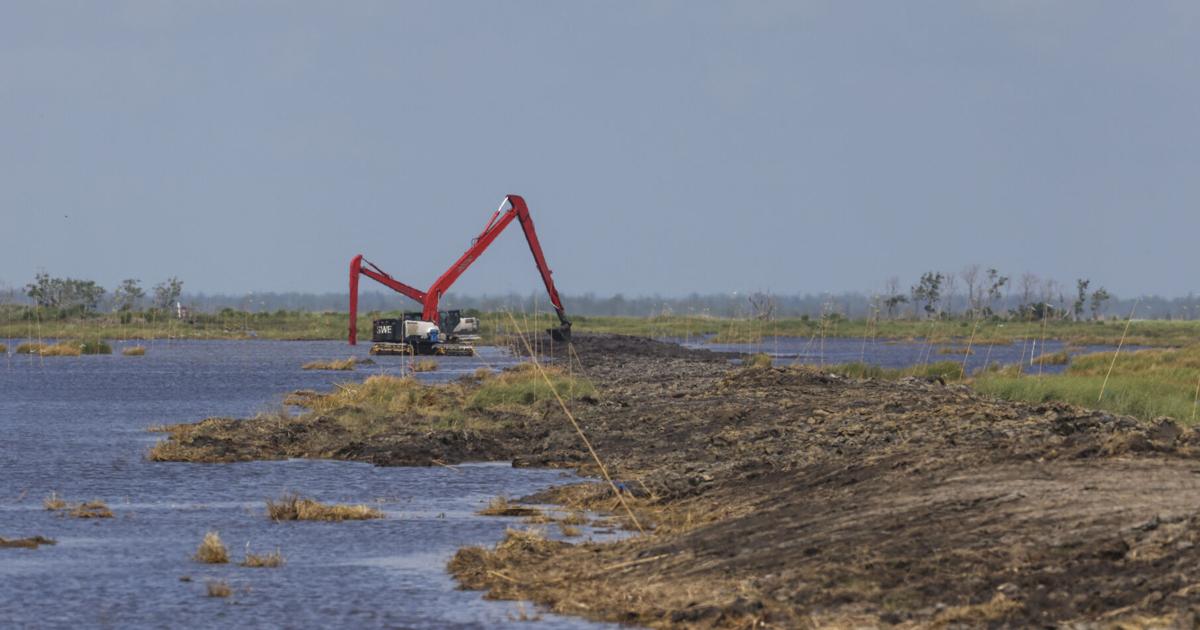Louisiana
She sued, claiming medical neglect at a Louisiana prison. Weeks later, she died at a hospital.

Several weeks after an inmate sued the Louisiana prison system, claiming medical negligence led to kidney failure, she died from complications related to that diagnosis, her family said.
Dana Smith, 62, died Nov. 13 at a Baton Rouge hospital after multi-organ failure, her family said. She arrived at the hospital days after filing suit in late October, suffering from sepsis, pneumonia, a drug-resistant staph infection, damaged kidneys and the flu, they say. Eventually her children decided to remove their mother from life support.
Beforehand, the family asked that their mother, who was in a medically induced coma for weeks, be unshackled. The hour before her death, Smith’s children were told she was approved for “compassionate release” — a bittersweet outcome that at least allowed her to “die a free woman [so] we could have her body,” said Jewley White, one of her daughters.
But the timing “was the most twisted, heartbreaking, unfair and unjust thing I could ever imagine,” she added.
Corrections department spokesman Ken Pastorick confirmed Smith was granted compassionate release Nov. 13. He declined to provide more information, citing the medical information involved and the litigation.
Smith was serving time for manslaughter, most recently at the Louisiana Correctional Institute for Women. Her family says their mother’s longstanding, severe health issues were not taken seriously by prison administrators.
“I feel so much anger and guilt, and the opposite of faith,” White said. “I cannot believe this is how her story ended.”
The allegation comes on the heels of federal oversight being imposed over another state prison, the Louisiana State Penitentiary at Angola. The judge in that case characterized the medical care there as “abhorrent” and “cruel.”
Untreated infection turned critical
In May 2022, a dentist at the prison filled one of Smith’s teeth with a temporary filling and scheduled her to return in six months for a permanent one, the lawsuit says. But the temporary filling wore down, and food trapped in the tooth caused a gum infection, the lawsuit alleges, leaving her with facial swelling, headaches and unable to chew on one side.
In July, the dentist — who isn’t named in the lawsuit — treated her again with a temporary filling. Smith was not given anything for the infection, the complaint says. It worsened, causing swelling down her neck. By November, Smith had requested several “emergency sick calls” for fever, swelling, pain and nausea, the lawsuit says.
The lawsuit claims that when she finally was allowed to see the dentist again, he “became irritated” and treated her “roughly” with the instruments. When Smith stood up from the chair to take a break from the pain, the dentist refused to finish the procedure, never refilled the tooth and didn’t provide an antibiotic, the lawsuit says.
Eventually she saw medical staff, but the nurse wouldn’t prescribe antibiotics, allegedly saying “there is nothing wrong with your mouth” after failing to examine her. The lawsuit says Smith begged for antibiotics but was denied both the medication and access to a doctor.
She was later repeatedly refused access to a doctor, including once by a nurse who said “she could not just walk in and demand medical attention,” the lawsuit claims.
She was finally pushed in a wheelchair by other inmates to the infirmary only to be told to return to her dorm, but was taken back again after losing control of her bowels, the lawsuit says. She was placed on the nursing ward and given a urine test — the results showed “an infection spilling into the urine from the blood stream,” which the nurses “either misinterpreted” as a standard urinary tract infection or “were grossly incompetent,” the complaint alleges.
“A doctor should have been called … to review the urine analysis and order appropriate tests or send her to an emergency room,” the lawsuit says. “No blood work or labs were ordered.”
Over three days in the nursing ward, Smith suffered from delirium stemming from the infection, receiving little care, the lawsuit says.
At last, the lawsuit says, inmate orderlies insisted an ambulance be called. The arriving paramedics were “disgusted with the condition” the now incoherent Smith was in, the lawsuit says. The nurses lied and said Smith had been “‘fine’” the day before, the lawsuit claims.
For weeks afterward, Smith was treated for sepsis, which had caused “severe and acute kidney failure and damage.” It took months for her to be able to walk, and she was placed on dialysis several times, according to the complaint.
But once back at the prison, she was not allowed the special diet needed by a patient in renal failure nor granted proper medical treatment, the lawsuit says.
Smith was again hospitalized in late October of this year, suffering from complications related to her damaged kidneys, her family said.
“Deterioration” behind bars
Smith had a series of health problems while in prison. In 2018, Smith ended up in the ICU with a collapsed lung, and she was treated for colon cancer in 2017 with surgery and chemotherapy, her family said.
“We basically watched our mom deteriorate,” said Joshua M. Butler, Smith’s son. “This is like an out of body experience, is the only way I can describe it. It does not feel real.”
Authorities said that while Toups was stealing the plants, Dunbar confronted him and the two fought. Toups beat Dunbar, then tied him up. Dunbar later died from his injuries, prosecutors said.
The prosecutor who argued the case said there was no intent to kill Dunbar.
For Smith’s children, the experience of watching from the outside as their mother grew ever sicker behind bars was torturous.
“My mom has always had us to advocate for her, and my heart truly breaks for the men and women who do not have anybody. I cannot imagine what it must be like,” said Jolei Parrott, one of Smith’s daughters. “I feel like my whole chest is ripping open.”

Louisiana
Saucier man identified as motorcyclist killed in crash in Louisiana

LAFOURCHE PARISH, La. (WLOX) – Saucier native Dustin Craven, 30, has been identified as the victim of a fatal single-vehicle crash in Louisiana, officials announced on Sunday.
The crash took place during the early morning hours of Sunday on Louisiana Highway 20 near Farmer Lane in Lafourche Parish. Craven, the driver of a 2022 Harley-Davidson Street Glide, was traveling south when the motorcycle left the roadway and struck a utility pole, causing him to be ejected.
As a result, Craven received fatal injuries and died at the scene.
The cause of the crash remains under investigation.
See a spelling or grammar error in this story? Report it to our team HERE.
Copyright 2024 WLOX. All rights reserved.
Louisiana
Live Updates: No. 14 Alabama Softball vs. Southeastern Louisiana (Tuscaloosa Regional Final)

TUSCALOOSA, Ala. — In a high-stakes NCAA Regional final qualifier on Saturday morning at Rhoads Stadium, Alabama Softball and Southeastern Louisiana went into extra innings. Riley Valentine, coming in as a pinch hitter, ignited a five-run rally in the ninth inning with a home run, propelling the Crimson Tide to a 6-3 victory.
After climbing their way back in the loser’s bracket, the Lions and Crimson Tide are set to face off once more on Sunday with a trip to the super regionals on the line. First pitch is scheduled for 1:00 p.m. CT on ESPN2.
BE SURE TO REFRESH YOUR BROWSER FOR THE LATEST UPDATES
(most recent at the top)
Current Score – T3: Alabama 9, SLU 2.
Top Third – SLU Batting:
Bottom Second – Alabama Batting:
Top Second- SLU Batting:
Bottom First – Alabama Batting:
Top First – SLU Batting:
Pregame:
|
Alabama |
SLU |
|---|---|
|
Kristen White |
Ka’Lyn Watson |
|
Larrissa Preuitt |
Chloe Magee |
|
Kenleigh Cahalan |
Maria Detillier |
|
Jenna Johnson |
Bailey Krolczyk |
|
Marlie Giles |
Lexi Johnson |
|
Bailey Dowling |
Maddie Watson |
|
Kali Heivilin |
Audrey Greely |
|
Riley Valentine |
Colleen Kulivan |
|
Emma Broadfoot |
Cam Goodman |
|
P: Jocelyn Briski |
P: Ellie DuBois |
Who: No. 14 Alabama (33-17), Clemson (34-17), Southeastern Louisiana (45-13) and USC Upstate (30-21)
Where: Rhoads Stadium, Tuscaloosa, Ala.
When:
Friday, May 17
*Southeastern Louisiana 6, Clemson 2 | 2 p.m. | ACC Network
*No. 14 Alabama1, USC Upstate 0 | 4:30 p.m. | ESPN+
Saturday, May 18
*Game 3: No. 14 Alabama 6, SLU 2 (9 Innings) | 10:30 a.m., ESPN+
*Game 4: Clemson 8, USC Upstate 0 (5 Innings) | 1 p.m. ESPN+
*Game 5: SLU 6, Clemson 2 | 4:30 p.m.
Sunday, May 19
*Game 6 | No. 14 Alabama vs. SLU | 1 p.m. | ESPN2
*Game 7 if necessary | TBD
Louisiana
Endangered whale spotted in western Gulf faces industrial dangers • Louisiana Illuminator

Evidence is mounting that an exceedingly rare whale, unique to the Gulf of Mexico, ranges farther west than previously thought, prompting new worries about the dangers it faces from heavy ship traffic and other industrial activities near Louisiana and Texas.
Scientists spotted two of the approximately 75 remaining Rice’s whales during an aerial survey of marine animals in the western Gulf last month. National Oceanic and Atmospheric Administration researcher Laura Dias saw one of the bus-size whales breaching the surface about 55 miles from Corpus Christi, Texas on April 11.
“I felt a wave of excitement and relief,” she said, describing the culmination of an “intense effort” to photograph the endangered whale species west of Louisiana. Found to be a distinct species just three years ago, the shy, deep-diving Rice’s whale remains largely a mystery. Scientists are racing to learn the basics, including how the whale eats, breeds and communicates, before the species goes extinct.
Recent audio recordings have also offered proof of the whale’s frequent travels in the western Gulf. A NOAA-led analysis of underwater sounds detected the whale’s distinctive “long moan” several times off the coasts of Louisiana and Texas, and offered the first evidence of the whale in Mexico’s waters.
“This is new knowledge and is critical for our understanding [of the whales] given how heavily industrialized that portion of the Gulf is,” said Melissa Soldevilla, a NOAA scientist who led the acoustical research.
The photos and recordings have upended the theory that the Rice’s whale rarely strayed from DeSoto Canyon in the eastern Gulf near Alabama and Florida.
Ships, oil and plastic
The new evidence was troubling for Michael Jasny, a marine mammal protection expert with the Natural Resources Defence Council.
“The vast majority of the risk this species faces is from vessel strikes,” he said. “There’s so much more vessel traffic in the central and western Gulf than there is in the east.”
Texas and Louisiana have several busy shipping hubs, including Houston, the U.S.’s fifth-largest container port, and Port Fourchon, which serves nearly all of the Gulf’s 3,200 active oil and gas structures.
Rice’s whales are “severely vulnerable” to ship strikes because they rest just below the surface at night, Jasny said. This behavior contrasts with most whales, which tend to be nocturnal. A dozing whale is less likely to notice an oncoming vessel, and the vessel’s crew is less likely to spot the whale in the dark.
In 2021, environmental groups petitioned NOAA to set a 10-knot speed limit around DeSoto Canyon. The proposal drew about 75,500 comments and strong opposition from the shipping and oil industries. In October, NOAA denied the petition in favor of an effort to get vessels to slow down voluntarily.
Jasny noted that NOAA adopted a similar 10-knot speed limit along the East Coast to protect the North Atlantic right whale, a species that’s also endangered but has a population that’s likely three times larger than the number of Rice’s whales.
Gulf Coast political leaders have expressed opposition to other measures to protect the whale, including a NOAA proposal to designate 28,000 acres in the Gulf as a new critical habitat.
On May 1, U.S. senators John Kennedy and Bill Cassidy of Louisiana and Cindy Hyde-Smith and Roger Wicker of Mississippi wrote a letter to NOAA warning against “unnecessary measures for the Rice’s whale at the expense of communities along the Gulf of Mexico.” The Republican senators believe whale-related restrictions on shipping and oil and gas development “would directly harm the economic activity and jobs.”
Rice’s whales are also threatened by oil spills, ocean trash, entanglement in fishing gear and noise, especially blasts from seismic airgun surveys that companies use to find offshore oil deposits.
BP’s Deepwater Horizon oil disaster in 2010 killed nearly 20% of the Rice’s whale population and likely caused widespread health problems and pregnancy failures, according to a NOAA-led assessment.
The growing problem of plastic pollution has also proved fatal for at least one of the whales. In 2019, a 38-foot-long male that washed up on a Florida beach was found to have been killed by a jagged piece of plastic that became lodged in its stomach.
Discovering a new species
The whale’s death had a silver lining, though. The carcass was a treasure trove of information for scientists and helped prove that the Rice’s whale is a distinct species.
Scientists had long thought Rice’s whales were a Gulf-dwelling variety of Bryde’s whales, another endangered species that ranges widely in the Atlantic and Pacific oceans. Rice’s and Bryde’s whales look almost identical. They grow to around 55 feet, weigh about 30 tons, use baleen to filter-feed and are part of what NOAA calls the “great whales,” a group that includes humpback, sperm and blue whales. But the dead specimen offered a rare opportunity to get a close look at the Rice’s whale’s organs, skeleton and DNA, all of which revealed clear differences.
A growing body of research indicates the whales’ behavior also sets them apart. While Bryde’s whales feed near the surface on a range of seafood, including krill, shrimp, herring and other small fish, Rice’s whales like to dive deep for one particular menu item: the silver-rag driftfish. And, unlike the free-ranging Bryde’s whales, Rice’s whales are homebodies, preferring to stick to the Gulf’s warm waters.
Some scientists wanted to name the newly-discovered species the “Gulf of Mexico whale” or the “American whale,” because it lives almost entirely in U.S. waters.
In the end, the NOAA scientists who confirmed the whale was a distinct species decided to name it in honor of Dale Rice, a biologist who first recognized some 60 years ago that the Bryde’s whales in the Gulf seemed different from other Bryde’s whales.
Regardless of what they’re called, Jasny hopes more Americans – especially Gulf Coast residents – come to appreciate this massive and mysterious animal, and understand how close it is to vanishing forever.
“This is a really remarkable species,” he said. “They’re unique to the Gulf and even the U.S. We want to make sure people realize how unique they are and how dependent they are on the habitat of the Gulf.”
This article first appeared on Verite News and is republished here under a Creative Commons license.![]()
-

 News1 week ago
News1 week agoSkeletal remains found almost 40 years ago identified as woman who disappeared in 1968
-

 World1 week ago
World1 week agoIndia Lok Sabha election 2024 Phase 4: Who votes and what’s at stake?
-

 Politics1 week ago
Politics1 week agoUS Border Patrol agents come under fire in 'use of force' while working southern border
-

 Politics1 week ago
Politics1 week agoTales from the trail: The blue states Trump eyes to turn red in November
-

 World1 week ago
World1 week agoBorrell: Spain, Ireland and others could recognise Palestine on 21 May
-

 Politics1 week ago
Politics1 week agoNorth Dakota gov, former presidential candidate Doug Burgum front and center at Trump New Jersey rally
-

 World1 week ago
World1 week agoCatalans vote in crucial regional election for the separatist movement
-

 World1 week ago
World1 week agoEurope matters to consumers, and so does your vote




















